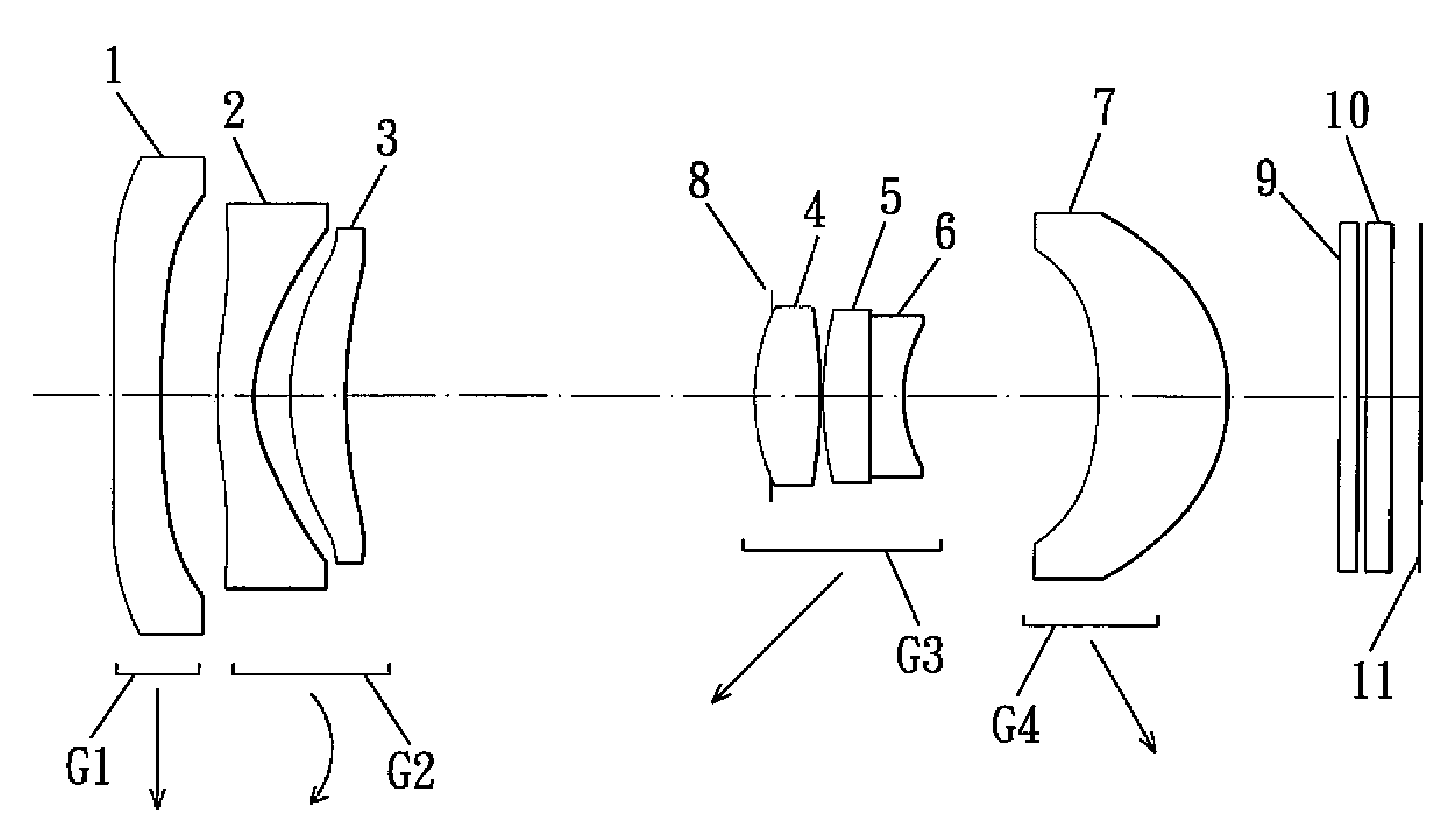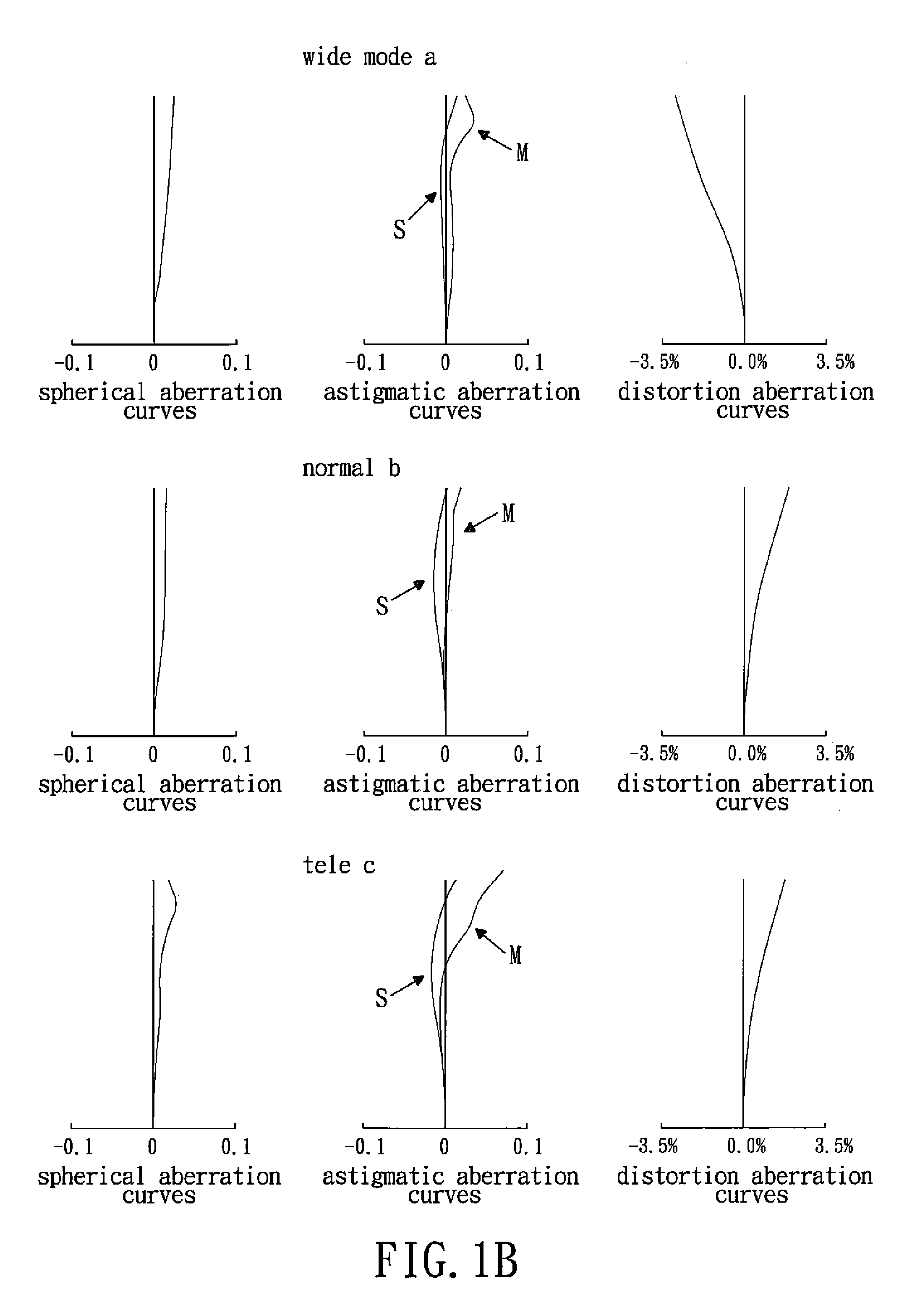Zoom lens system
- Summary
- Abstract
- Description
- Claims
- Application Information
AI Technical Summary
Benefits of technology
Problems solved by technology
Method used
Image
Examples
first embodiment
[0038]The first embodiment related description:
[0039]A focal length f of the zoom lens system f=5.07 mm˜9.35 mm˜14.49 mm, aperture stop value F=3.11˜4.50˜5.90, field of view 2ω=59.9˜33.1˜21.7 degrees, and zoom ratio=2.86, and these are the data in the modes of wide, mid and tele, respectively. As shown in table 1A, the numbers 1, 2, 3 . . . 19 represent the sequence numbers of the respective surface of the zoom lens system from the object to image side. r represents the radius of curvature (paraxial radius of curvature, its unit is mm), d (mm) is a distance between surfaces, nd is the index of refraction, and vd means reciprocal dispersion of the respective optical materials of the respective embodiments of the zoom lens system. And table 1B shows the aspheric surface coefficients of the respective surfaces of the respective embodiments of the zoom lens system.
[0040]
TABLE 1Ardndvd1∞0.751.5135756.8217.2700.89~2.46~2.2136.6900.651.5434056.542.4400.5853.8360.851.6073026.666.4456.86~2.4...
second embodiment
[0047]The second embodiment related description:
[0048]A focal length f of the zoom lens system f=5.06 mm˜9.43 mm˜14.27 mm, aperture stop value F=3.05˜4.51˜5.78, field of view 2ω=60.0˜32.8˜22.1 degrees, and zoom ratio=2.82, and these are the data in the modes of wide, mid and tele, respectively. Table 2A shows the data of the respective lens elements. And table 2B shows the aspheric surface coefficients of the respective surfaces of the respective embodiments of the zoom lens system. Both surfaces of the fifth and sixth lens elements 5, 6 are spherical, and the surfaces of other lens elements are plastic and aspheric.
[0049]
TABLE 2Ardndvd1∞0.571.5135756.8210.9800.89~2.32~0.8935.6340.571.5434056.542.6630.3854.2040.671.6320023.466.2836.27~2.02~0.667∞−0.2683.4351.001.5920167.09−9.1920.05106.0020.791.8830040.811−40.3570.011.5140038.812−40.3570.641.7173629.5132.2583.27~6.79~9.6514−5.1191.941.5135756.815−2.5461.32~0.63~0.5516∞0.301.5168064.217∞0.1018∞0.401.5168064.219∞0.50
[0050]
TABLE 2BSurf...
third embodiment
[0051]The third embodiment related description:
[0052]A focal length f of the zoom lens system f=5.05 mm˜9.42 mm˜14.32 mm, aperture stop value F=2.84˜4.20˜5.40, field of view 2ω=60.1˜32.8˜22.0 degrees, and zoom ratio=2.84, and these are the data in the modes of wide, mid and tele, respectively. Table 3A shows the data of the respective lens elements. And table 3B shows the aspheric surface coefficients of the respective surfaces of the respective embodiments of the zoom lens system. Both surfaces of the fifth and sixth lens elements 5, 6 are spherical, and the surfaces of other lens elements are plastic and aspheric.
[0053]
TABLE 3Ardndvd11573.8340.571.5135756.8211.0130.89~2.34~0.8935.7130.571.5434056.542.6960.3854.0290.661.6320023.465.7876.34~2.08~0.717∞−0.3183.4351.051.6188163.99−9.1920.05106.0020.811.8830040.811−40.3570.011.5140038.812−40.3570.591.7173629.5132.2583.33~6.83~9.7114−5.1191.911.5135756.815−2.5461.25~0.57~0.5116∞0.301.5168064.217∞0.1018∞0.401.5168064.219∞0.50
[0054]
TABLE ...
PUM
 Login to View More
Login to View More Abstract
Description
Claims
Application Information
 Login to View More
Login to View More - R&D
- Intellectual Property
- Life Sciences
- Materials
- Tech Scout
- Unparalleled Data Quality
- Higher Quality Content
- 60% Fewer Hallucinations
Browse by: Latest US Patents, China's latest patents, Technical Efficacy Thesaurus, Application Domain, Technology Topic, Popular Technical Reports.
© 2025 PatSnap. All rights reserved.Legal|Privacy policy|Modern Slavery Act Transparency Statement|Sitemap|About US| Contact US: help@patsnap.com



